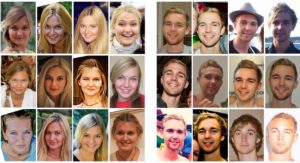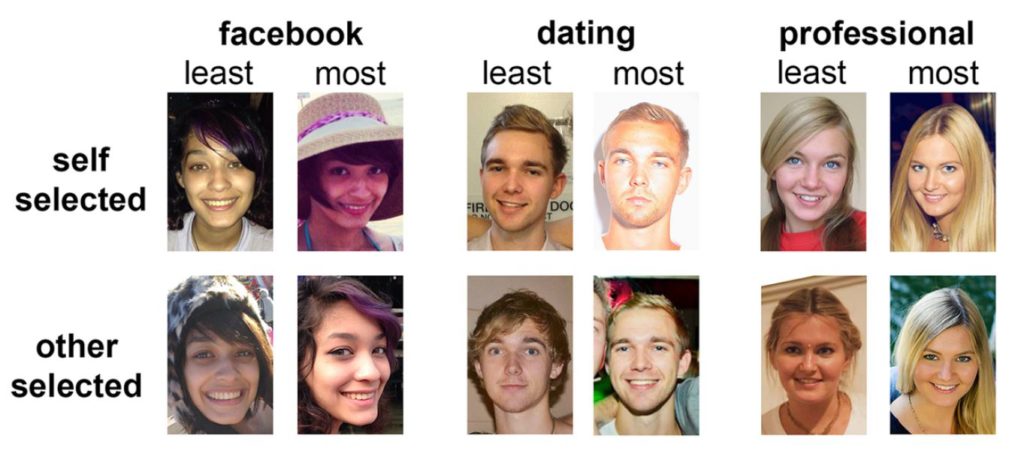Did you meet your partner online? As recently as 2005, few Americans would have answered this question in the affirmative, but according to Pew Research, in 2016 around 15% of Americans reported using online dating sites or mobile dating apps. Among 18-24 year olds, more than a quarter (27%) engaged in online dating, and among 55-64 year olds the prevalence was 12%. One consequence of internet dating is that “individuals who face a thin market for potential partners, such as gays, lesbians, and middle aged heterosexuals, are especially likely to meet partners online”, thereby increasing the partnership rate for same-sex couples. And in Britain, half of people that are currently searching for a relationship have used online dating. (By the way, a recent CNBC review of sites can be found here.)
Regardless of which site you are using, they all require their customers to post a profile, including a picture of themselves. Consumer Reports suggests how one can boost the odds with a better profile: “Use recent pictures (taken within the past year) and at least one good close-up headshot.”
But which recent close-up headshot should you choose? Should you choose it at all, or should you ask a friend or relative to make the choice? A Google search yields several interesting candidates although it is unclear if they are particularly helpful (see below for an example):

At first glance, profile pictures on dating sites may not appear to constitute an obvious target for cognitive research. However, on further thought, profile pictures are far from trivial: people’s photos are presented in many other choice contexts, for example when employers are searching for potential employees online, or when a President-elect wishes everyone a Merry Christmas via Twitter:

Given that people form impressions of others within a split second of exposure to a person’s photograph, and given that those impressions can predict real-world outcomes—including the success of political candidates—the choice of one’s profile picture may have surprisingly far-reaching consequences indeed.
A recent article in the Psychonomic Society’s journal Cognitive Research: Principles & Implications (CRPI) therefore examined the way in which the choice of profile picture might be optimized.
Researchers David White, Clare Sutherland and Amy Burton asked undergraduate participants to provide 12 photos of their face from their Facebook gallery. The picture below shows a set of photos from two participants:

In the first phase of the study, the 12 photos of their own face were presented to each participant. The participant’s task was to select which of the 12 images they were most (or least) likely to use as profile picture in three online contexts: a social network (Facebook), dating sites (e.g., match.com) and professional networks (e.g., LinkedIN). Participants then also rated their photos on five dimensions of social impressions (attractiveness, trustworthiness, dominance, competence, and confidence).
Each participant additionally performed the same selection and rating tasks for the 12 images provided by a different, randomly chosen participant in the experiment.
The first phase of the experiment thus yielded two sets of choices of pictures for the same pool of people: one set was chosen by each person themselves, and the other set was chosen by a different person.
Which of those sets might be more suitable to generate positive first impressions?
This question was addressed in the next phase of the study. White and colleagues recruited a large online sample of viewers who rated the pictures that had been selected during the first phase on the traits of attractiveness, trustworthiness, and competence. The figure below shows the complete set presented to those additional online viewers for 3 participants from the first phase (although only 2 of those pictures—“least” and “most” likely from one design cell—would be shown to any given viewer from the second phase, with the remainder distributed across multiple other viewers):

The results from this second phase are shown in the figure below. Each bar represents the difference in ratings between the “most” and “least” likely choices. A positive difference is indicative of the most likely choice being rated higher on the various dimensions than the least likely choice, which is what one would hope for if one is selecting one’s profile picture to generate the best possible first impression.

Several aspects of the results are noteworthy. First, independent viewers by and large rate the most likely choices higher than the least likely picture, attesting to the fact that people tend to do a good job choosing their own (or someone else’s) best picture.
Second, depending on the context, different traits are emphasized by the selection of the most likely picture: in the Facebook and dating context, attractiveness features prominently, whereas in the professional context attractiveness is dwarfed by competence. This attests to the fact that people are aware of what attributes are relevant in different contexts, and they are able to choose pictures to satisfy those attributes.
Third, and perhaps most notably, the difference scores are systematically higher for pictures that were chosen by others during the first phase, rather than by the participant herself. (One exception to this concerns the attractiveness ratings only, which do not differ between self and other).
In a nutshell, the second phase of the study shows that self-selected profile images conferred less favorable impressions when compared to other-selected images. Thus, although we all have a lifetime of practice with self-enhancement, which is the very human and very pervasive tendency to portray ourselves as positively as possible, we apparently are less-skilled self-enhancers than we are other-enhancers.
The research by White and colleagues confirms the wisdom of the 30% of women (and 16% of men) who are using dating sites and are already routinely asking friends for help with their profile.
Article focused on in this post:
White, D., Sutherland, C. A. M., & Burton, A. L. (2017). Choosing face: The curse of self in profile image selection. Cognitive Research: Principles and Implications, 2, 23. DOI 10.1186/s41235-017-0058-3
